https://www.youtube.com/watch?v=zZYI4Kji0Pw
NEVER EVER Grill a Steak again - Skillet Seared Steak
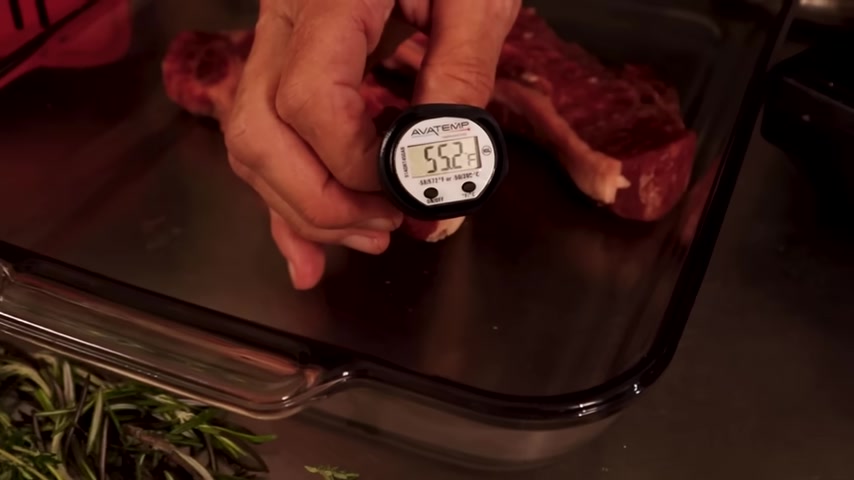
I really love to grill out and I actually have three grills on my back patio .
And during the summer in nice weather , I grill out almost every night of the week .
And one of my favorite things to grill is a nice juicy thick steak .
But I'm gonna show you a method today that you've probably heard about .
Once you master this method , you may never want to cook a steak on a grill again because it's so so good .
Welcome to all things food with John Woods .
I love to cook , but I cook to love .
So let's talk food .
So I told you that I love the grill .
So the other night I took some beautiful steaks home .
They were about an inch to an inch and a half thick .
And I wanted to cook those on my grill , but a terrible storm came up in our area and it lasted for hours and hours and there , I was with a hunger for those beautiful steaks .
So , what did I do ?
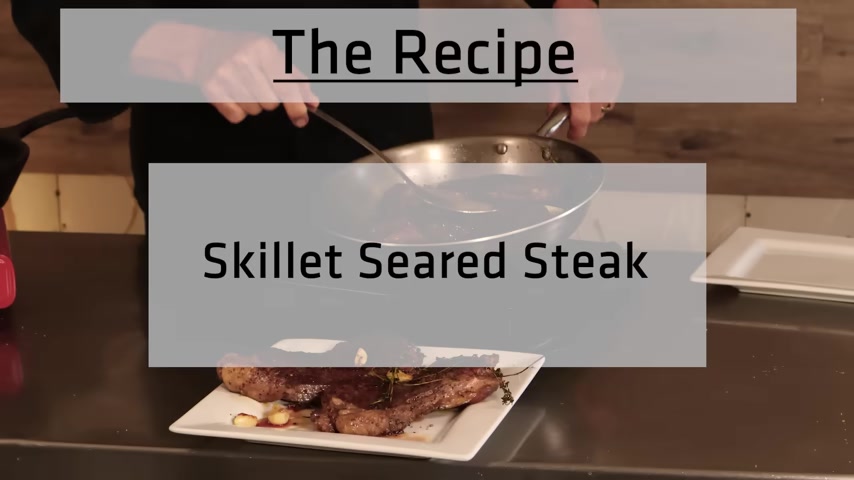
Well , I reverted to one of the great methods of all time to cook a steak , real restaurant , quality steak right there in my own home .
And that was seared steak in a skillet .
And I'm gonna share with you some of the basic principles today to help you really cook a really fine quality steak right there inside your own kitchen .
So , let's go .
So , the first step is we want to select a good quality the steak .
If you're gonna spend time cooking a steak and spend the money cooking a steak , be sure you buy a really good quality steak .
Don't skimp and buy a cheap steak .
Find one with good marbling .
If you're not exactly certain how to select a good steak .
Talk to your butcher and they'll be very glad to help you .
But it starts with a good steak tip .
Number two is temper your steak .
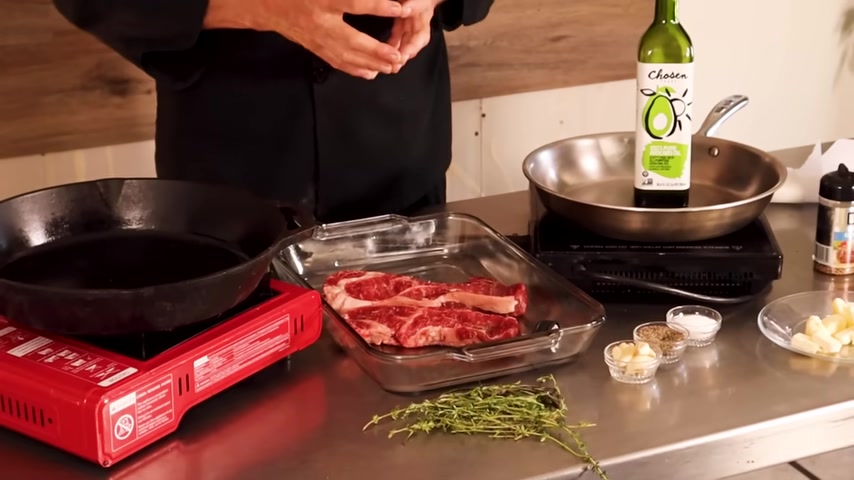
So many people will take their meat , whether it's a steak or a pot roast or whatever it is directly out of the refrigerator at 40 41 degrees and put it in a skillet and try to cook it .
That's really not a good idea .
It's always better to temper your steak and bring it up to room temperature .
Now , a lot of videos will tell you to put it out for 20 or 30 minutes , but I did an experiment today to tell you that that's not near long enough .
So I took these beautiful New York strips out of the refrigerator , temp them at 41 degrees at this point .
They've been at room temperature 68 to 70 degrees for almost three hours .
Now , this check the internal temperature and see what they are at this point .
It looks like they're not even quite 60 degrees .
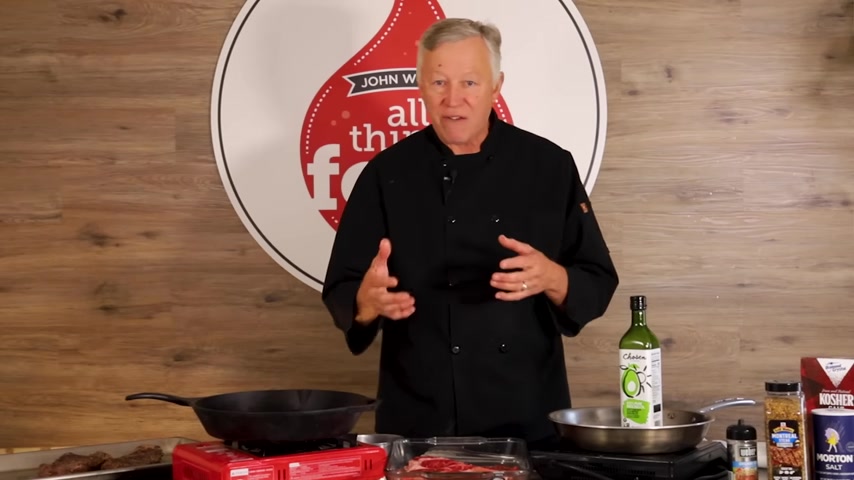
So whenever you temper a steak , be sure you put it out at room temperature in a room that's 68 to 70 degrees for an extended period of time , 2 to 3 hours at the , at the very minimum .
And I think you're going to find you're going to have a much better quality steak by doing so .
Point number three , if you want a good seared steak , remove any moisture , I always take a paper towel and I try to blot it dry as much as possible , removing any excess moisture .
Always remember that moisture is an enemy to searing .
We don't want to our steak .
We want to sear the steak , so we're gonna remove all the excess moisture as much as possible .
Our fourth step is we want to adequately season the steak .
And remember that seasoning is gonna require more than you actually think .
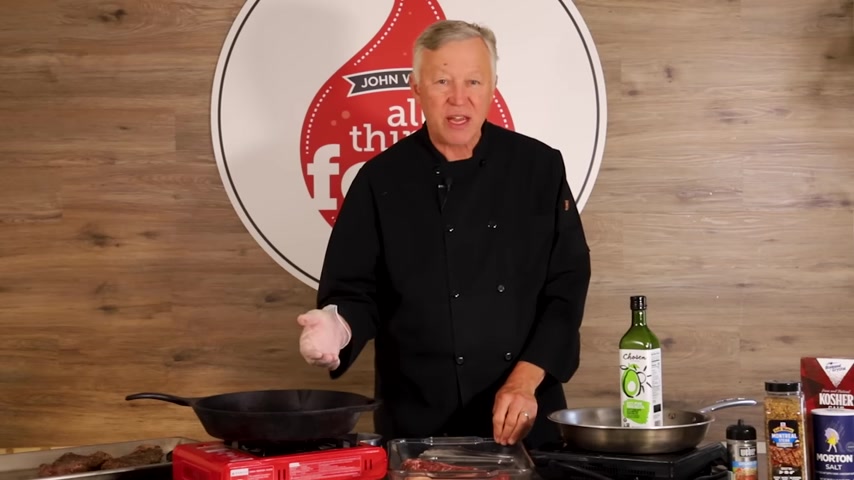
Um , when you put the steak in the skillet after you've seasoned it , it's gonna lose about 30% of the seasoning that you put on it into the skillet .
So how do we season the steak ?
Well , the simplest thing to do good old salt and pepper and I always like to use kosher salt .
Do not use table salt .
I have the table salt here .
This is a , no , no , you don't wanna use table salt on just about anything , especially a good steak .
So get some good kosher salt .
I like Diamond brand .
Um , it's really good , fine coarse salt and I'm gonna salt it very generously .
Both sides .
I'm gonna get some good coarse pepper .
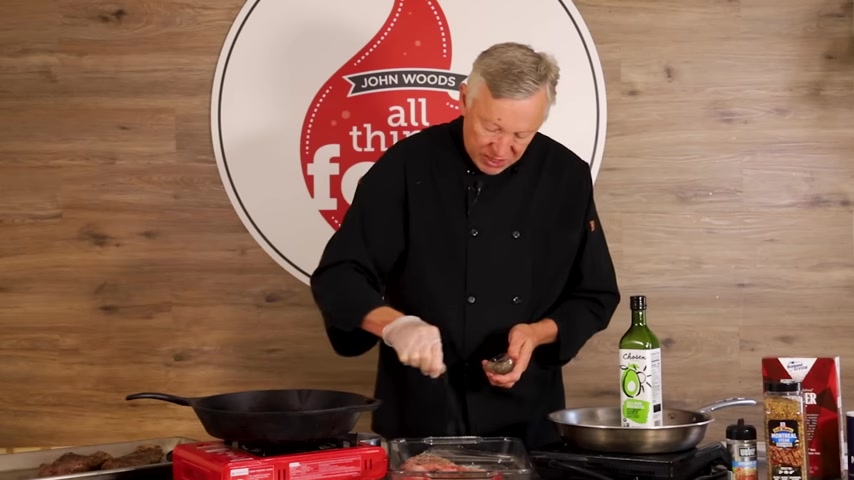
You use ground pepper , but I'm just gonna use this already pre ground pepper here generously sees on both sides and then I'm not only gonna season both sides , I'm gonna take it and turn it up on its edge and season the edges of the steak .
We want that seasoning to be permeating the entire steak .
So there's a good seasoning .
Now , there's a good seasoning that I like to use a lot of times that if I'm not using salt and pepper , I love Montreal steak .
It has garlic and salt and pepper , really a really fine steak seasoning .
And I , I love to use this whenever I can .
Another good one is , um , Weber's Chicago steak seasoning .
So it's whatever your preference .
But if you're in the , you have salt and pepper , that's exactly one of the best ways to do it .
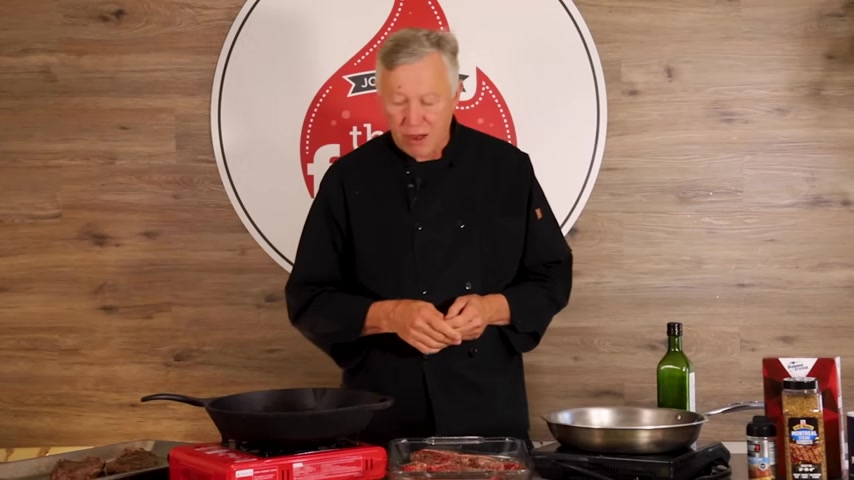
Step number five is select the right skillet .
Um , whenever you're searing a steak , you want to use something that's real heavy , it will stand up to a lot of heat .
Of course , the best option is the good old trusty cast iron skillet .
One that's well seasoned .
And so we're gonna do two .
We have a stainless steel skillet over here on my induction burner and we're gonna bring those up to temperature , get them very , very hot .
And before we add the oil , now , let's talk about the oil .
Um , I'd like to use a , um , avocado oil because it has a very high smoke point of 525 degrees .
A good substitute would be grape seed oil .
Even though it has a smoke point of only about 4 , 25 I think avocado oil is always the best choice .
It's mild .
It's nutty .
It's sweet .
It's just really a good choice whenever you're searing a steak .
So once these skillets get hot , we're going to add the oil .
Don't add the oil first .
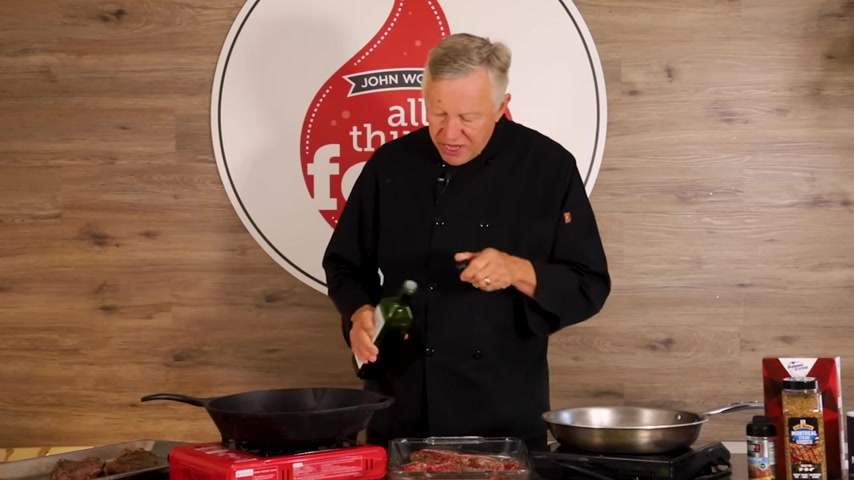
Wait until they get hot before you add the oil .
So it looks like our skillet .
This cast iron is pretty hot .
I'm gonna go ahead and add a couple tablespoons of oil .
Not too much and we're gonna sear the steak .
Um , there are a couple of things you can do here .
There's one thing called a reverse here where we actually start the steak in the oven , probably cook it at 300 degrees and on a preheated sheet pan for maybe 15 minutes , 10 minutes , depending on the thickness of the steak .
But I usually cook it almost to about 20% shy of the doneness that I'm wanting .
So , um , so you started it in the oven and that's actually what I've already done for you today .
Um , we , we uh pre sear these in the oven and we're gonna finish those in the skillet here and that's what we call a reverse sear .
Now , the skill is pretty hot .
It's not gonna take very long to do this , maybe about two minutes on each side .
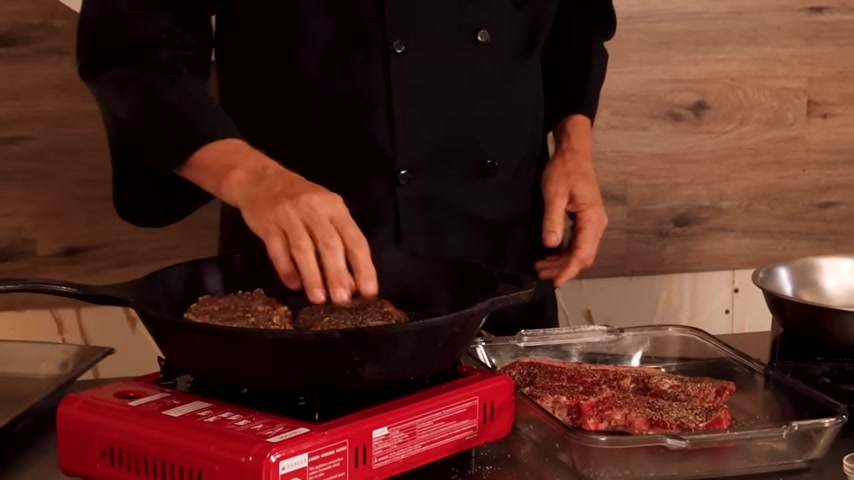
And then we're gonna have a really , really nice steak , put it in away from you .
Listen for that sizzle , press it down to make sure it's getting full coverage there .
And we're gonna let that cook for about two minutes .
At this point .
I'm gonna add a couple aromatics , a little bit of thyme , a little bit of rosemary .
Just throw it right in there .
Come over here and add some garlic , couple cloves of garlic and then we're gonna put some butter in , let that melt .
And we don't want to move our steaks around a lot .
Just let the skillet do the work .
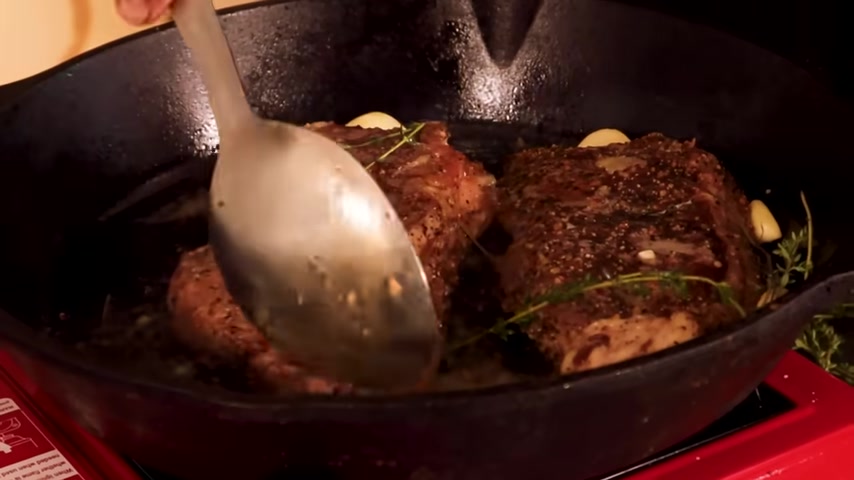
Don't flip them , don't flop them .
Just let them cook .
We'll take some of that butter and base up on the steak here .
It's been about two minutes .
We're gonna turn those over , shake them anyway .
Let them cook just another minute or two .
Continue to ba our other skillet over here is getting fairly hot .
You add some oil to it , that'll get good .
And he remember this is the pre Seared , um , reverse Sear method and this one here , we're just gonna sear right on the skillet .
We're gonna cook this for about three minutes on each side .
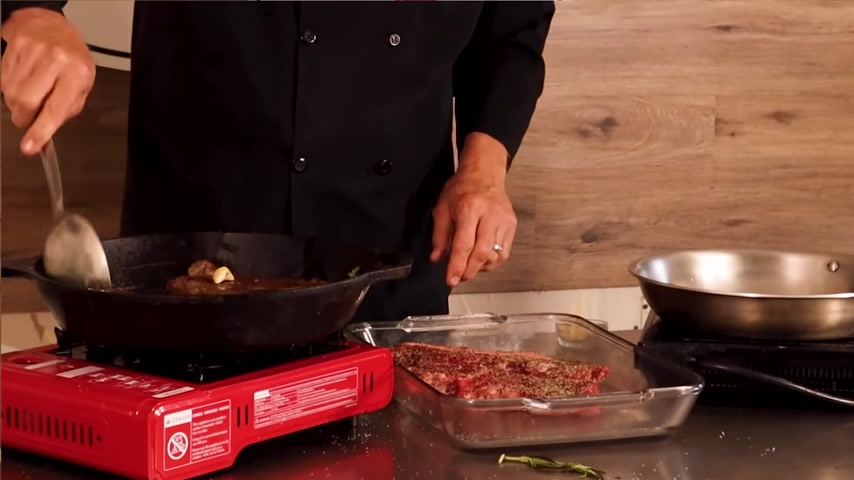
Once that gets warm and turn these over another two minutes since we've already precooked these a little bit .
Continue to baste nice and crisp on the outside .
They are looking absolutely beautiful .
Can hardly wait to try those .
So these steaks are sizzling hot .
I'm going to take them out of here and put them on a plate and let them rest for about five minutes or so .
Don't want to cut into them right away .
Take some of our aromatics and throw on top of that , set these aside and let them rest for just a few minutes .
And then we'll enjoy here .
We have the two stakes that we did not uh , reverse here .
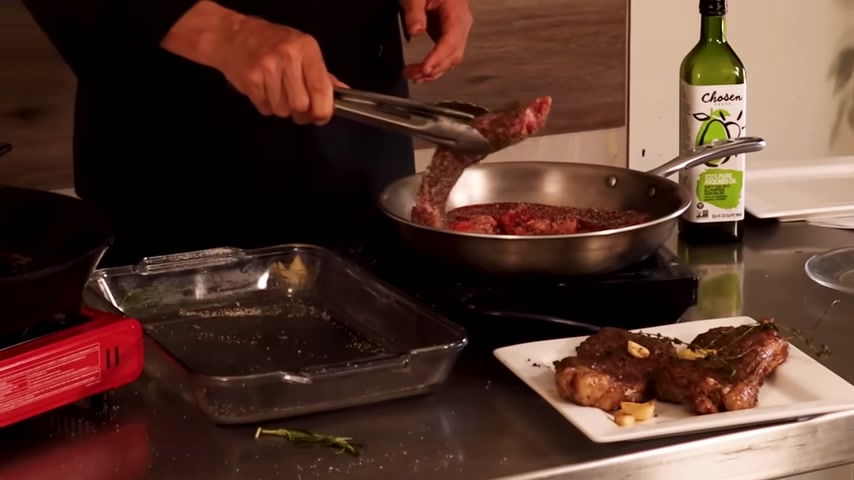
We're gonna put them in a very hot skillet and , um , see what happens again , put them away from us and don't overcrowd your steaks .
If , when you , when you're cooking on a skillet , don't put too many steaks in at one time because again , it'll steam the steak rather than searing the steak .
Press that down to make sure we have good coverage everywhere .
I'm gonna throw in my aromatics , thyme and rosemary garlic .
And then we're gonna let that cook a minute or two , then we're gonna throw in some butter and baste it .
Ok , see if it's time to turn these , just let them cook just another minute or two .
And I always like to let them cook that first three minutes .
Actually , before I put my butter in there again .
That's your preference .
But that's kind of the way I like to do .
It really smells wonderful .
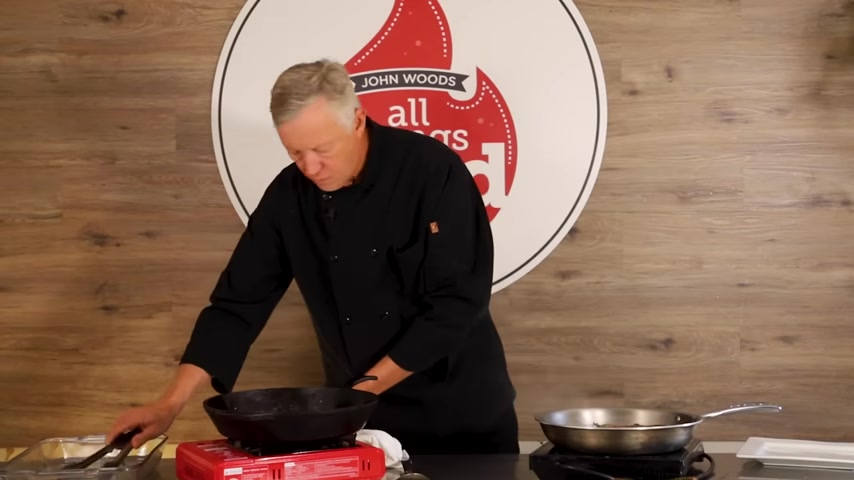
Those aromatics really adds a lot of flavor to the steak .
Nice , golden brown and crispy .
Go ahead and add my butter in here and then we'll base these steaks with that butter .
I'm gonna cook these to about a medium rare .
That's my preference .
Probably about 100 and 30 degrees internal temperature .
Let's talk about checking the temperature of a steak .
A lot of people are afraid to use a thermometer for some reason .
They , I guess they think it's just the wrong thing to do .
But if you're going to cook a good steak , don't have an aversion to using a thermometer .
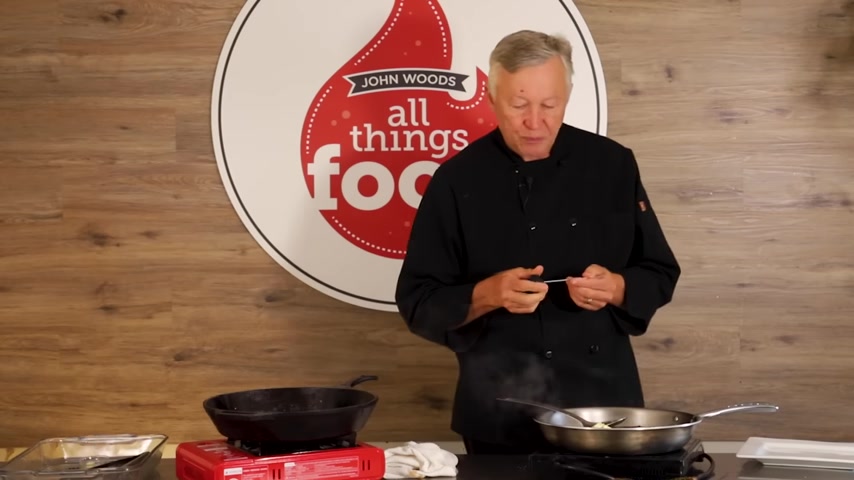
Try to get a good digital thermometer and when you check the temperature of the steak , be sure to go through the side of the steak right into the very middle and you need to leave the thermometer in there for exactly , for about a minimum of 15 seconds for it to register properly .
We're one of these steaks to be about 1 30 ish or so .
And let me check over here and see if it looks like we're at exactly 100 and 29 degrees internal on that steak .
So that's exactly perfect .
These are gonna put three minutes on each side and we're gonna pull them out and let them rest .
We're gonna check the temperature and let them rest .
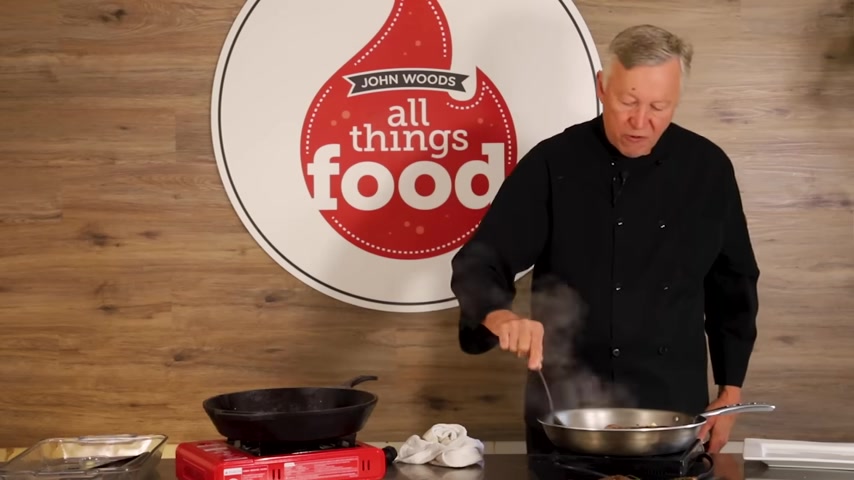
Now , there's a little trick if you don't have a digital thermometer or a good thermometer , you can kind of check the dumbness of a steak by touching your , the palm of your hand .
That part of your hand right there , your palm where it's real soft .
That would be the feel of a rare steak .
If you move your finger up a little higher there , maybe put those two fingers together .
That would be like a medium rare , medium , well and well done .
So , um , so you can just feel the steak like right now , that's exactly a rare .
It feels just like that part of my ham .
Um , if I wanted it well done , it would feel like that part of my palm right there .
So right now the steak feels rare but it's getting the , the desired dumbness that I want a medium rare that we're getting pretty close right about 1 .
17 .
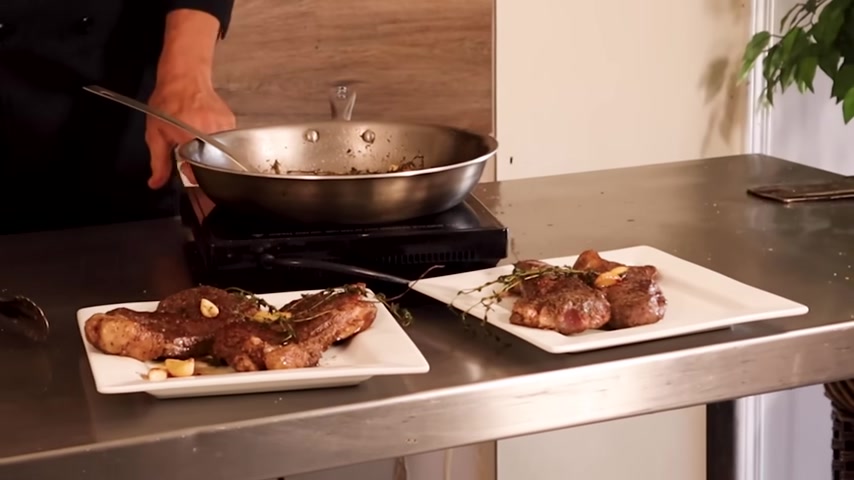
I don't think you can actually get a steak any better than this .
It'd be hard to .
So now is the moment of truth , this is the steak .
These are the steaks that we reverse sear .
We started those in the oven , cook them for about 10 minutes and then finish them in the skillet here .
And then these , these are the ones that we seared in the skillet , cook completely in the skillet .
Now , we could have actually started these in the skillet , searing them in the skillet and then finish them in the oven .
That's a good method to do as well .
But these , here we cook completely in the skillet .
So let's cut one open and see what we have again .
I was looking kind of for a rare to medium , uh rare steak .
Exactly what we were looking for .
Nice , beautiful mate .
So I'm gonna try a bite of this and see how it is .
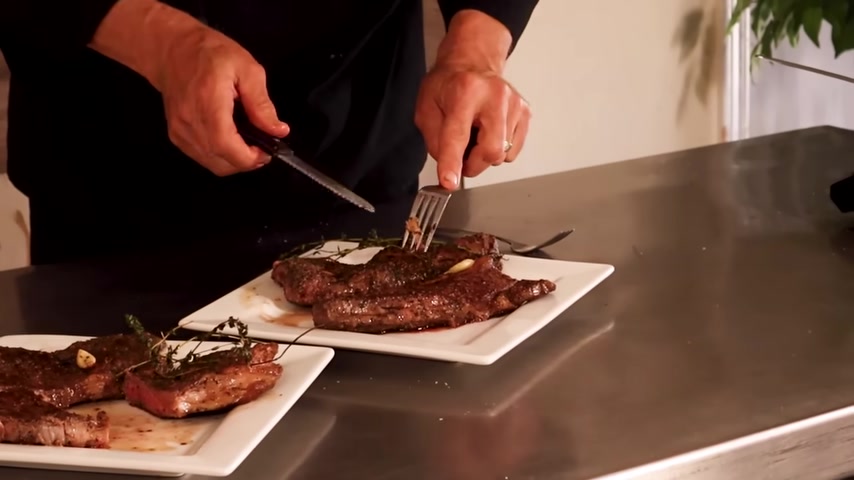
Flavor is magnificent .
Texture is really good .
I give that steak in a plus .
And these are the steaks that we've actually cooked in the skillet .
Again .
I'm looking for a rare to medium rare steak .
The way I prefer it , texture is good .
Color is good .
I let the thing rest for about five minutes or so and I'll take a bite and this one's a little rarer than that one , but that's kind of the way I wanted it actually .
Hm .
So good .
So if I had to make a decision between a reverse sear steak and then just searing one and then perhaps finishing off in the oven or finish it in the skillet , I think I would go with this method .
The one that we seared the steak completely in the skillet first rather than the reverse syrup .
That's just my preference .
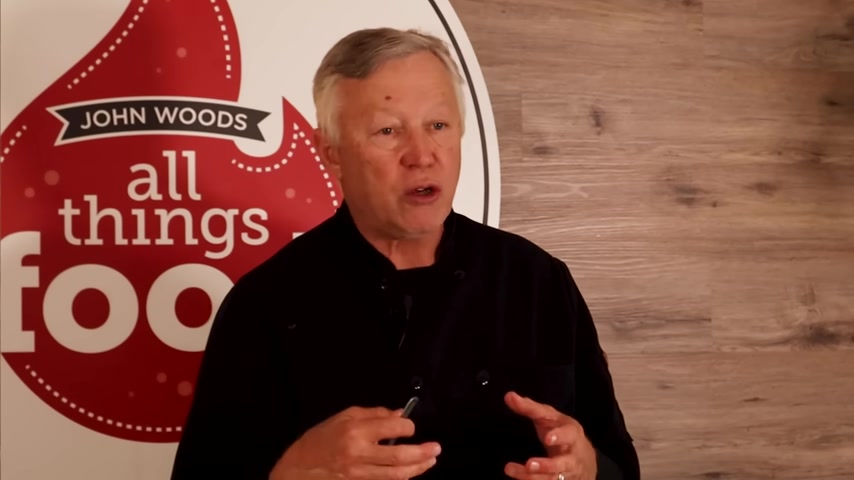
But give it a try , try both methods , see which one works better for you .
So the next time you have that rainy day and you can't get out on your grill , but you're just dying for a steak and you want a good crispy juicy restaurant .
Quality steak .
Please use these methods that I discussed today on how to sear a steak in a skillet .
I think you're gonna be very , very happy .
Thank you for watching today .
If you learned one thing that was a value today , please hit the subscribe button .
It's not gonna cost you one penny .
We won't hound you with emails , but it'll help our channel to grow and share this with someone .
Hit the like button and I'll see you next week on all things .
Food with John Woods .
Are you looking for a way to reach a wider audience and get more views on your videos?
Our innovative video to text transcribing service can help you do just that.
We provide accurate transcriptions of your videos along with visual content that will help you attract new viewers and keep them engaged. Plus, our data analytics and ad campaign tools can help you monetize your content and maximize your revenue.
Let's partner up and take your video content to the next level!
Contact us today to learn more.